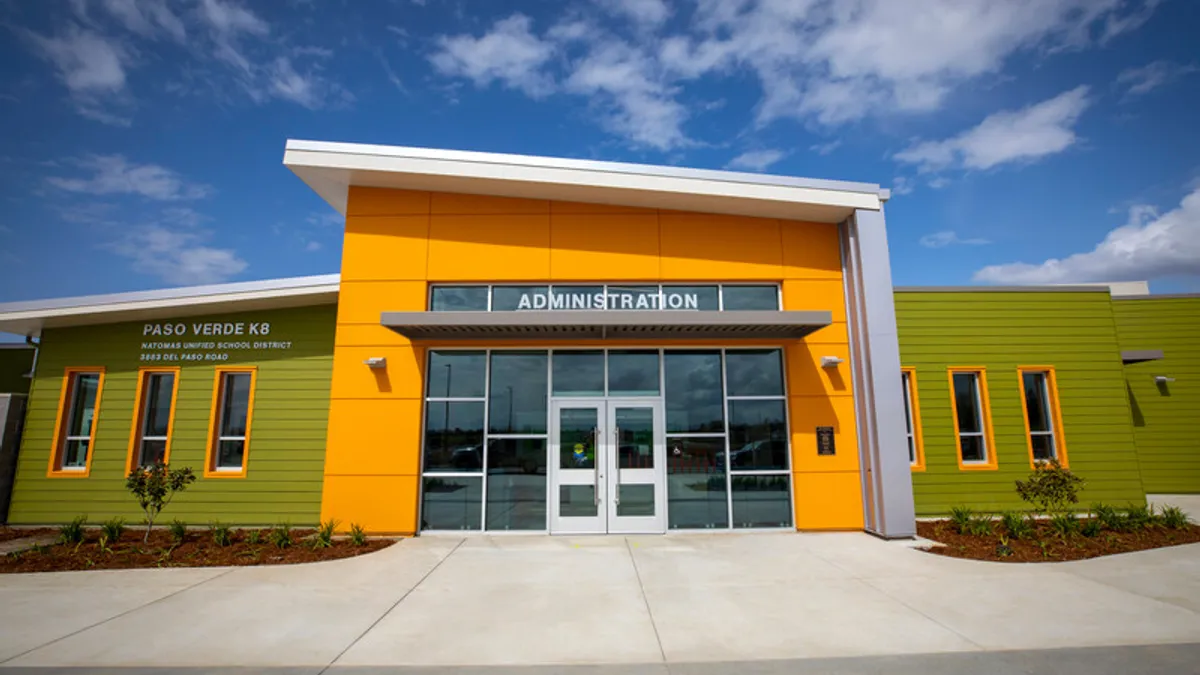Using a variety of tactics, The Boldt Company saved $5 million on the construction of a new K-8 public school in Sacramento, California.
The project team for the Paso Verde School faced a series of pandemic-related challenges after starting construction on the $60 million facility in May 2019.
The pandemic caused major disruptions to the supply chain for building materials and halted typical communication on the jobsite. The project supply chain was impacted by shutdowns in manufacturing plants and transportation delays as supplies were re-routed due to COVID-19.
For example, the cement shortage in Northern California significantly delayed concrete installation on the project. Manufacturing delays affected windows, roofing, flooring and casework. Flooring that was manufactured in South Korea needed to be re-sourced, and materials made in California had to be shifted to manufacturing facilities in Texas and Kentucky.
The new facility, which was completed in March, includes a 19-acre campus with six buildings, approximately 38 teaching stations and more than 90,000 square feet, serving approximately 1,000 students. The campus includes an administration building, gym with locker rooms, science labs, multipurpose room, music room, amphitheater and an outdoor garden space.
Designed by Sacramento-based Lionakis Architects, the school was originally planned with many spaces for collaborative learning and with extensive outdoor classrooms, so no significant changes in design were needed to comply with social distancing once the pandemic arrived. However, air handling units received more scrutiny.
"The system was designed above and beyond what was needed, but we had to make sure it was operating to the highest capacity before occupancy," said Boldt Project Manager Bobby Barney in a press release shared with Construction Dive. "We conducted thorough testing and balancing prior to opening."
But even with the challenges, the Boldt team managed to save millions on the project. Students are currently in class for the 2021/2022 school year due to the outdoor collaborative spaces.
The project was built under California's lease/leaseback statute that allows a school district to lease property it owns to a developer, who in turn builds a school facility on the property and leases the facility back to the school district. The benefit of this statute is that the school district can select the builder and is able to work with them in a collaborative way.
For example, some of the significant changes included:
- Design called for overhead folding doors and Boldt's pre-construction managers suggested swapping them with a storefront window application for a savings of $1,652,567.
- Teams changed enclosure systems to a James Hardie siding system and Tyvek commercial wrap was used as a weather barrier in place of a fluid-applied barrier for a savings of $1,503,157.
- Spray-lock was used instead of a vapor emission control system for a savings of $364,795.
- Crews used fabric and class II aggregate base in place of time treating soil under onsite hardscape for a savings of $259,252.
- Boldt eliminated intersection manhole work and modified only the existing manhole base channeling for a savings of $163,492.
- Concrete cast-in-place seat walls were used in place of precast for a savings of about $163,492. This was used on the amphitheater and outdoor benches around the site.
Funding for school renovations
More school districts are feeling the pressure for facility expansion because the pandemic has made work-from-home arrangements more popular, Brooke Higman, project executive for The Boldt Company, said in the press release. She said that families that were once tied to metropolitan areas due to jobs are now able to move to more suburban and rural areas, which may be the catalyst for school expansion.
Accelerated by the pandemic, dense core counties of major U.S. metro areas saw a net decrease in flow into the city, while other suburbs and some smaller cities saw net gains, according to Bloomberg.
Congress directed close to $200 billion to state and local education agencies in 2020 and 2021 to help reopen schools. The American Rescue Plan (ARP), signed into law by President Joe Biden in March, directly addresses the pandemic-related student learning recovery.
But supply chain issues, shortages and inflationary prices are making it challenging for districts to invest in school facility construction, said Sasha Pudelski, director of advocacy at the School Superintendents Association (AASA). About 16% of districts indicated they would spend between 26% to 50% of ARP funding on school improvements, while 45% of districts indicated they would spend between 1% to 10% of ARP funding on those improvements, according to an AASA report.












